International Finance: Analyzing GSK's Strategy and Performance
VerifiedAdded on 2023/06/18
|10
|3161
|440
Report
AI Summary
This report provides an analysis of Glaxo Smith Kline's (GSK) international finance strategies, focusing on recent developments impacting the company, key elements of its risk management strategy, and financial performance. It examines the effects of changes in borrowing rates and financial support from governments during crises like COVID-19. The report discusses GSK's sources of finance, including derivative financial instruments, hedging strategies, and borrowing methods, as well as its dividend policy. A detailed financial performance analysis is conducted using ratio analysis, covering profitability, liquidity, and efficiency ratios to assess GSK's financial strengths and weaknesses. The analysis includes net profit margin, operating profit margin, current ratio, quick ratio, working capital turnover, and debt-to-equity ratio, offering insights into the company's financial health and operational effectiveness. Desklib provides access to this document and many more solved assignments for students.

International Finance
Paraphrase This Document
Need a fresh take? Get an instant paraphrase of this document with our AI Paraphraser
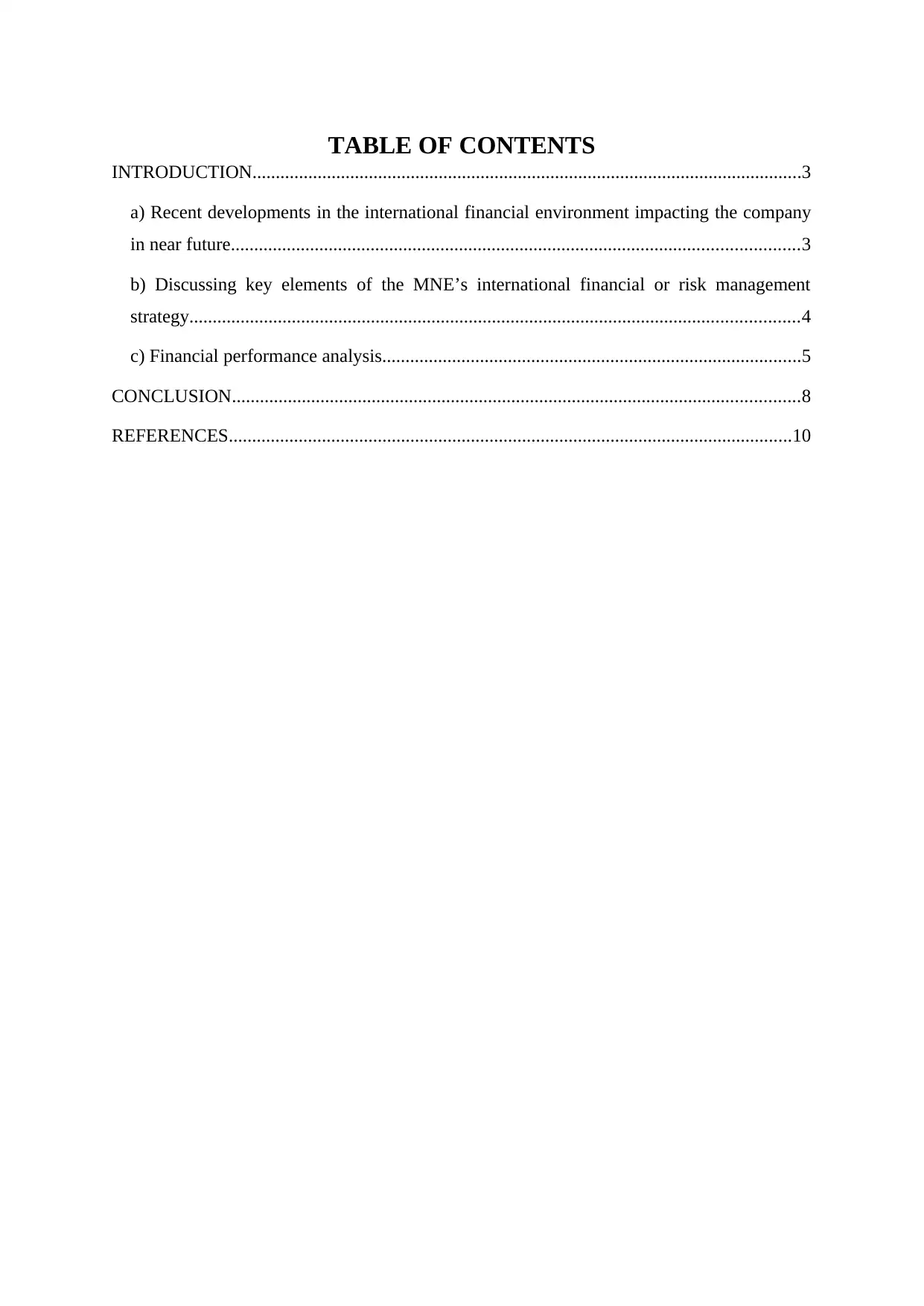
TABLE OF CONTENTS
INTRODUCTION......................................................................................................................3
a) Recent developments in the international financial environment impacting the company
in near future..........................................................................................................................3
b) Discussing key elements of the MNE’s international financial or risk management
strategy...................................................................................................................................4
c) Financial performance analysis..........................................................................................5
CONCLUSION..........................................................................................................................8
REFERENCES.........................................................................................................................10
INTRODUCTION......................................................................................................................3
a) Recent developments in the international financial environment impacting the company
in near future..........................................................................................................................3
b) Discussing key elements of the MNE’s international financial or risk management
strategy...................................................................................................................................4
c) Financial performance analysis..........................................................................................5
CONCLUSION..........................................................................................................................8
REFERENCES.........................................................................................................................10
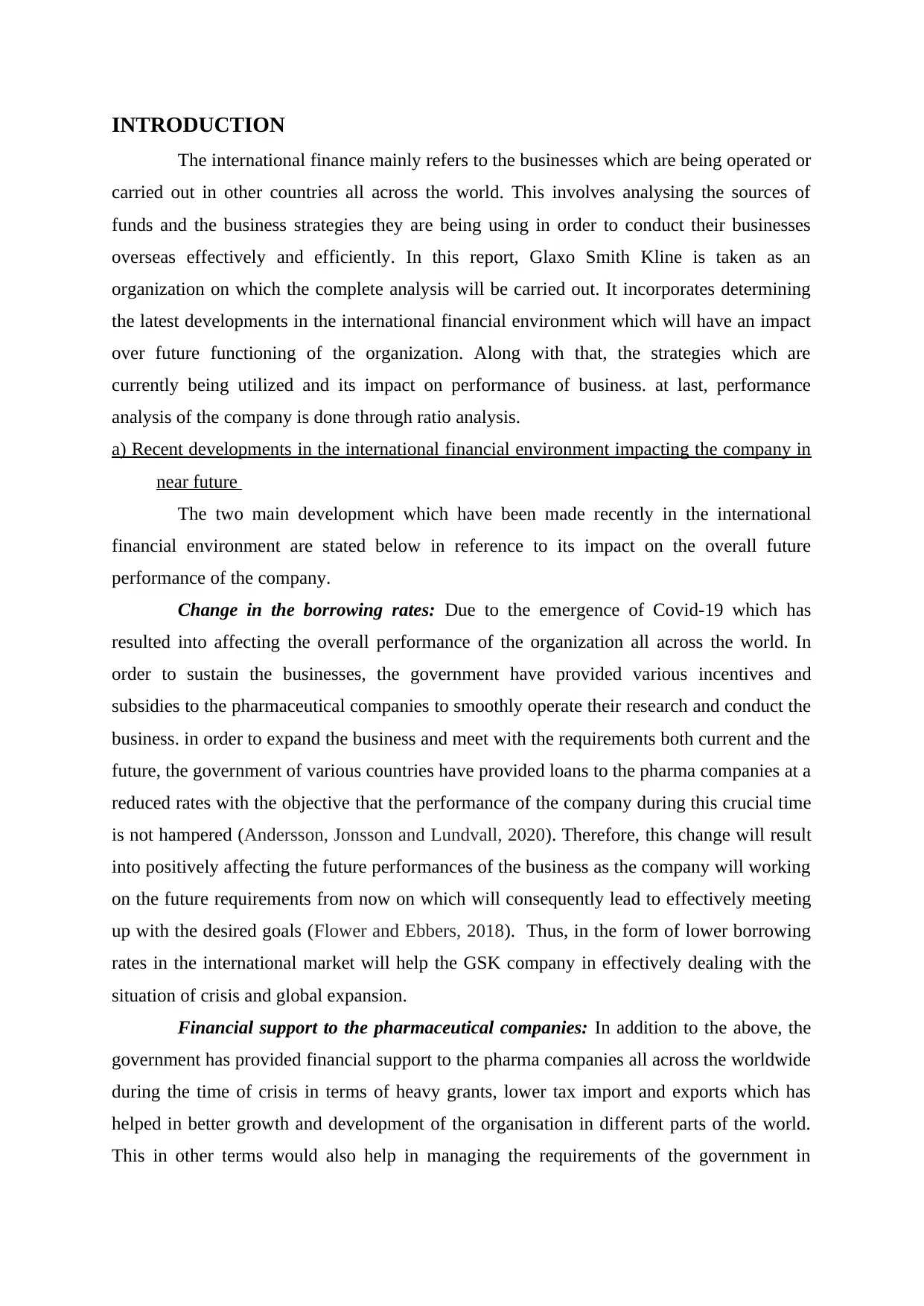
INTRODUCTION
The international finance mainly refers to the businesses which are being operated or
carried out in other countries all across the world. This involves analysing the sources of
funds and the business strategies they are being using in order to conduct their businesses
overseas effectively and efficiently. In this report, Glaxo Smith Kline is taken as an
organization on which the complete analysis will be carried out. It incorporates determining
the latest developments in the international financial environment which will have an impact
over future functioning of the organization. Along with that, the strategies which are
currently being utilized and its impact on performance of business. at last, performance
analysis of the company is done through ratio analysis.
a) Recent developments in the international financial environment impacting the company in
near future
The two main development which have been made recently in the international
financial environment are stated below in reference to its impact on the overall future
performance of the company.
Change in the borrowing rates: Due to the emergence of Covid-19 which has
resulted into affecting the overall performance of the organization all across the world. In
order to sustain the businesses, the government have provided various incentives and
subsidies to the pharmaceutical companies to smoothly operate their research and conduct the
business. in order to expand the business and meet with the requirements both current and the
future, the government of various countries have provided loans to the pharma companies at a
reduced rates with the objective that the performance of the company during this crucial time
is not hampered (Andersson, Jonsson and Lundvall, 2020). Therefore, this change will result
into positively affecting the future performances of the business as the company will working
on the future requirements from now on which will consequently lead to effectively meeting
up with the desired goals (Flower and Ebbers, 2018). Thus, in the form of lower borrowing
rates in the international market will help the GSK company in effectively dealing with the
situation of crisis and global expansion.
Financial support to the pharmaceutical companies: In addition to the above, the
government has provided financial support to the pharma companies all across the worldwide
during the time of crisis in terms of heavy grants, lower tax import and exports which has
helped in better growth and development of the organisation in different parts of the world.
This in other terms would also help in managing the requirements of the government in
The international finance mainly refers to the businesses which are being operated or
carried out in other countries all across the world. This involves analysing the sources of
funds and the business strategies they are being using in order to conduct their businesses
overseas effectively and efficiently. In this report, Glaxo Smith Kline is taken as an
organization on which the complete analysis will be carried out. It incorporates determining
the latest developments in the international financial environment which will have an impact
over future functioning of the organization. Along with that, the strategies which are
currently being utilized and its impact on performance of business. at last, performance
analysis of the company is done through ratio analysis.
a) Recent developments in the international financial environment impacting the company in
near future
The two main development which have been made recently in the international
financial environment are stated below in reference to its impact on the overall future
performance of the company.
Change in the borrowing rates: Due to the emergence of Covid-19 which has
resulted into affecting the overall performance of the organization all across the world. In
order to sustain the businesses, the government have provided various incentives and
subsidies to the pharmaceutical companies to smoothly operate their research and conduct the
business. in order to expand the business and meet with the requirements both current and the
future, the government of various countries have provided loans to the pharma companies at a
reduced rates with the objective that the performance of the company during this crucial time
is not hampered (Andersson, Jonsson and Lundvall, 2020). Therefore, this change will result
into positively affecting the future performances of the business as the company will working
on the future requirements from now on which will consequently lead to effectively meeting
up with the desired goals (Flower and Ebbers, 2018). Thus, in the form of lower borrowing
rates in the international market will help the GSK company in effectively dealing with the
situation of crisis and global expansion.
Financial support to the pharmaceutical companies: In addition to the above, the
government has provided financial support to the pharma companies all across the worldwide
during the time of crisis in terms of heavy grants, lower tax import and exports which has
helped in better growth and development of the organisation in different parts of the world.
This in other terms would also help in managing the requirements of the government in
⊘ This is a preview!⊘
Do you want full access?
Subscribe today to unlock all pages.

Trusted by 1+ million students worldwide
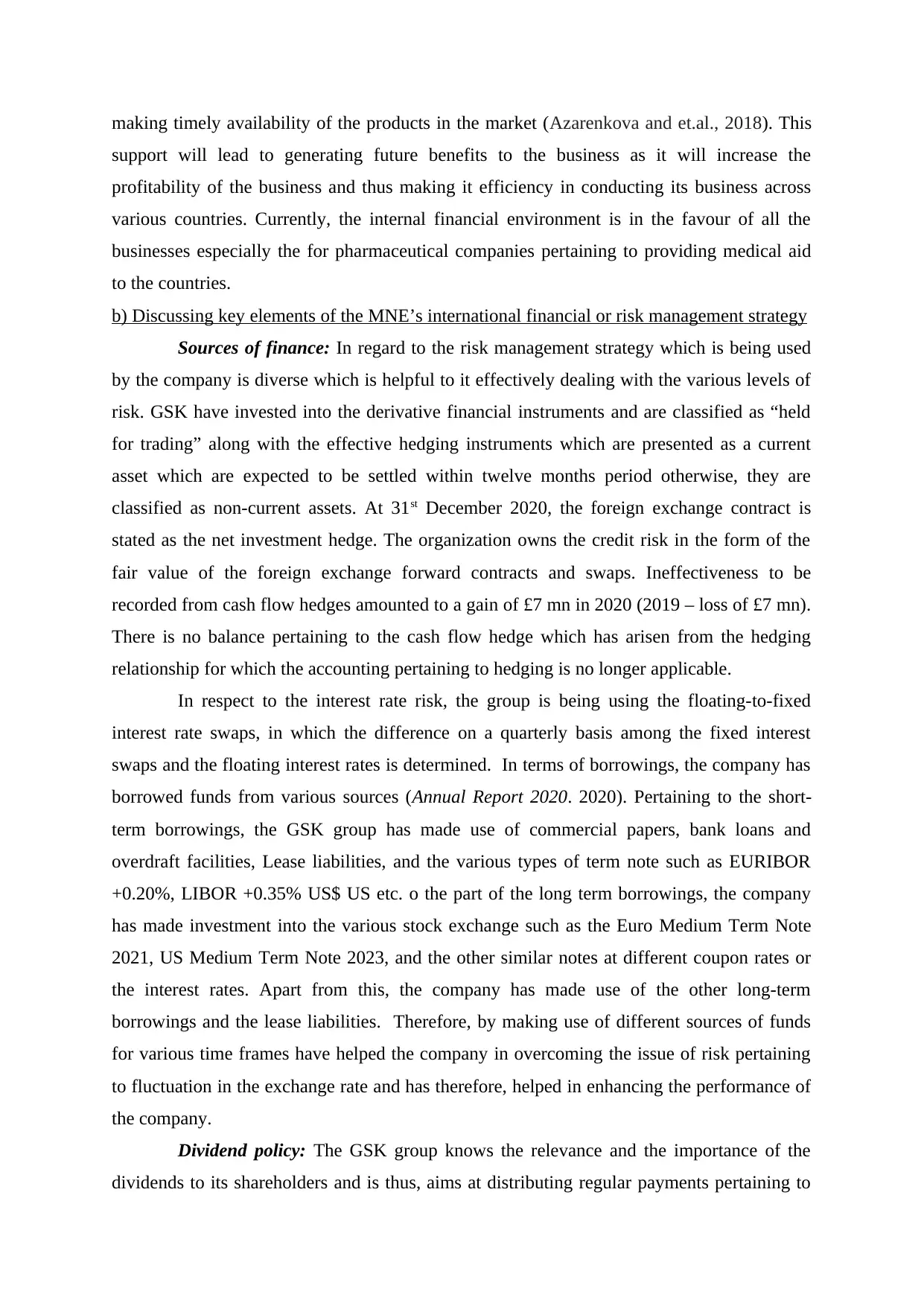
making timely availability of the products in the market (Azarenkova and et.al., 2018). This
support will lead to generating future benefits to the business as it will increase the
profitability of the business and thus making it efficiency in conducting its business across
various countries. Currently, the internal financial environment is in the favour of all the
businesses especially the for pharmaceutical companies pertaining to providing medical aid
to the countries.
b) Discussing key elements of the MNE’s international financial or risk management strategy
Sources of finance: In regard to the risk management strategy which is being used
by the company is diverse which is helpful to it effectively dealing with the various levels of
risk. GSK have invested into the derivative financial instruments and are classified as “held
for trading” along with the effective hedging instruments which are presented as a current
asset which are expected to be settled within twelve months period otherwise, they are
classified as non-current assets. At 31st December 2020, the foreign exchange contract is
stated as the net investment hedge. The organization owns the credit risk in the form of the
fair value of the foreign exchange forward contracts and swaps. Ineffectiveness to be
recorded from cash flow hedges amounted to a gain of £7 mn in 2020 (2019 – loss of £7 mn).
There is no balance pertaining to the cash flow hedge which has arisen from the hedging
relationship for which the accounting pertaining to hedging is no longer applicable.
In respect to the interest rate risk, the group is being using the floating-to-fixed
interest rate swaps, in which the difference on a quarterly basis among the fixed interest
swaps and the floating interest rates is determined. In terms of borrowings, the company has
borrowed funds from various sources (Annual Report 2020. 2020). Pertaining to the short-
term borrowings, the GSK group has made use of commercial papers, bank loans and
overdraft facilities, Lease liabilities, and the various types of term note such as EURIBOR
+0.20%, LIBOR +0.35% US$ US etc. o the part of the long term borrowings, the company
has made investment into the various stock exchange such as the Euro Medium Term Note
2021, US Medium Term Note 2023, and the other similar notes at different coupon rates or
the interest rates. Apart from this, the company has made use of the other long-term
borrowings and the lease liabilities. Therefore, by making use of different sources of funds
for various time frames have helped the company in overcoming the issue of risk pertaining
to fluctuation in the exchange rate and has therefore, helped in enhancing the performance of
the company.
Dividend policy: The GSK group knows the relevance and the importance of the
dividends to its shareholders and is thus, aims at distributing regular payments pertaining to
support will lead to generating future benefits to the business as it will increase the
profitability of the business and thus making it efficiency in conducting its business across
various countries. Currently, the internal financial environment is in the favour of all the
businesses especially the for pharmaceutical companies pertaining to providing medical aid
to the countries.
b) Discussing key elements of the MNE’s international financial or risk management strategy
Sources of finance: In regard to the risk management strategy which is being used
by the company is diverse which is helpful to it effectively dealing with the various levels of
risk. GSK have invested into the derivative financial instruments and are classified as “held
for trading” along with the effective hedging instruments which are presented as a current
asset which are expected to be settled within twelve months period otherwise, they are
classified as non-current assets. At 31st December 2020, the foreign exchange contract is
stated as the net investment hedge. The organization owns the credit risk in the form of the
fair value of the foreign exchange forward contracts and swaps. Ineffectiveness to be
recorded from cash flow hedges amounted to a gain of £7 mn in 2020 (2019 – loss of £7 mn).
There is no balance pertaining to the cash flow hedge which has arisen from the hedging
relationship for which the accounting pertaining to hedging is no longer applicable.
In respect to the interest rate risk, the group is being using the floating-to-fixed
interest rate swaps, in which the difference on a quarterly basis among the fixed interest
swaps and the floating interest rates is determined. In terms of borrowings, the company has
borrowed funds from various sources (Annual Report 2020. 2020). Pertaining to the short-
term borrowings, the GSK group has made use of commercial papers, bank loans and
overdraft facilities, Lease liabilities, and the various types of term note such as EURIBOR
+0.20%, LIBOR +0.35% US$ US etc. o the part of the long term borrowings, the company
has made investment into the various stock exchange such as the Euro Medium Term Note
2021, US Medium Term Note 2023, and the other similar notes at different coupon rates or
the interest rates. Apart from this, the company has made use of the other long-term
borrowings and the lease liabilities. Therefore, by making use of different sources of funds
for various time frames have helped the company in overcoming the issue of risk pertaining
to fluctuation in the exchange rate and has therefore, helped in enhancing the performance of
the company.
Dividend policy: The GSK group knows the relevance and the importance of the
dividends to its shareholders and is thus, aims at distributing regular payments pertaining to
Paraphrase This Document
Need a fresh take? Get an instant paraphrase of this document with our AI Paraphraser
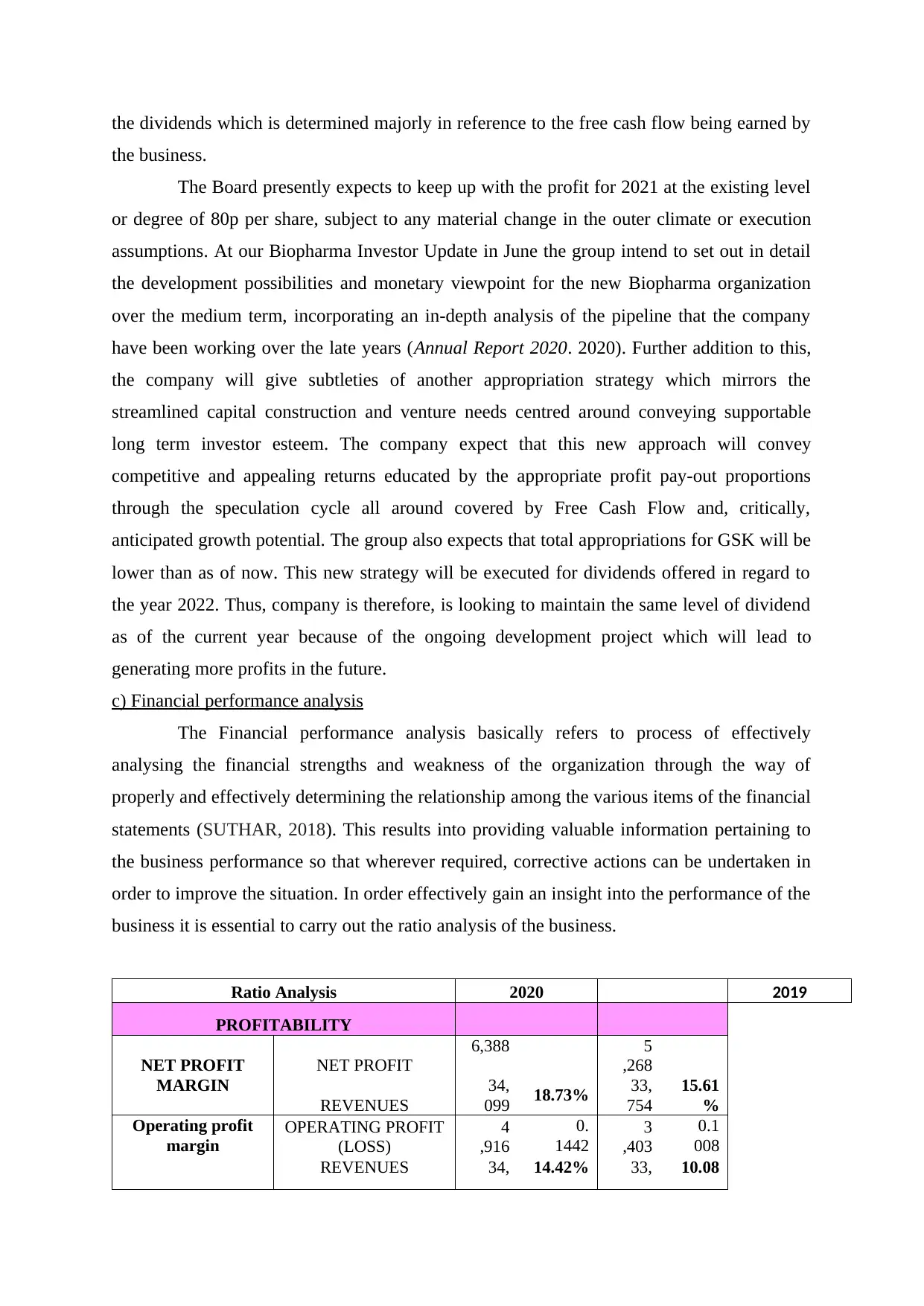
the dividends which is determined majorly in reference to the free cash flow being earned by
the business.
The Board presently expects to keep up with the profit for 2021 at the existing level
or degree of 80p per share, subject to any material change in the outer climate or execution
assumptions. At our Biopharma Investor Update in June the group intend to set out in detail
the development possibilities and monetary viewpoint for the new Biopharma organization
over the medium term, incorporating an in-depth analysis of the pipeline that the company
have been working over the late years (Annual Report 2020. 2020). Further addition to this,
the company will give subtleties of another appropriation strategy which mirrors the
streamlined capital construction and venture needs centred around conveying supportable
long term investor esteem. The company expect that this new approach will convey
competitive and appealing returns educated by the appropriate profit pay-out proportions
through the speculation cycle all around covered by Free Cash Flow and, critically,
anticipated growth potential. The group also expects that total appropriations for GSK will be
lower than as of now. This new strategy will be executed for dividends offered in regard to
the year 2022. Thus, company is therefore, is looking to maintain the same level of dividend
as of the current year because of the ongoing development project which will lead to
generating more profits in the future.
c) Financial performance analysis
The Financial performance analysis basically refers to process of effectively
analysing the financial strengths and weakness of the organization through the way of
properly and effectively determining the relationship among the various items of the financial
statements (SUTHAR, 2018). This results into providing valuable information pertaining to
the business performance so that wherever required, corrective actions can be undertaken in
order to improve the situation. In order effectively gain an insight into the performance of the
business it is essential to carry out the ratio analysis of the business.
Ratio Analysis 2020 2019
PROFITABILITY
NET PROFIT
MARGIN
NET PROFIT
6,388 5
,268
REVENUES
34,
099 18.73% 33,
754
15.61
%
Operating profit
margin
OPERATING PROFIT
(LOSS)
4
,916
0.
1442
3
,403
0.1
008
REVENUES 34, 14.42% 33, 10.08
the business.
The Board presently expects to keep up with the profit for 2021 at the existing level
or degree of 80p per share, subject to any material change in the outer climate or execution
assumptions. At our Biopharma Investor Update in June the group intend to set out in detail
the development possibilities and monetary viewpoint for the new Biopharma organization
over the medium term, incorporating an in-depth analysis of the pipeline that the company
have been working over the late years (Annual Report 2020. 2020). Further addition to this,
the company will give subtleties of another appropriation strategy which mirrors the
streamlined capital construction and venture needs centred around conveying supportable
long term investor esteem. The company expect that this new approach will convey
competitive and appealing returns educated by the appropriate profit pay-out proportions
through the speculation cycle all around covered by Free Cash Flow and, critically,
anticipated growth potential. The group also expects that total appropriations for GSK will be
lower than as of now. This new strategy will be executed for dividends offered in regard to
the year 2022. Thus, company is therefore, is looking to maintain the same level of dividend
as of the current year because of the ongoing development project which will lead to
generating more profits in the future.
c) Financial performance analysis
The Financial performance analysis basically refers to process of effectively
analysing the financial strengths and weakness of the organization through the way of
properly and effectively determining the relationship among the various items of the financial
statements (SUTHAR, 2018). This results into providing valuable information pertaining to
the business performance so that wherever required, corrective actions can be undertaken in
order to improve the situation. In order effectively gain an insight into the performance of the
business it is essential to carry out the ratio analysis of the business.
Ratio Analysis 2020 2019
PROFITABILITY
NET PROFIT
MARGIN
NET PROFIT
6,388 5
,268
REVENUES
34,
099 18.73% 33,
754
15.61
%
Operating profit
margin
OPERATING PROFIT
(LOSS)
4
,916
0.
1442
3
,403
0.1
008
REVENUES 34, 14.42% 33, 10.08
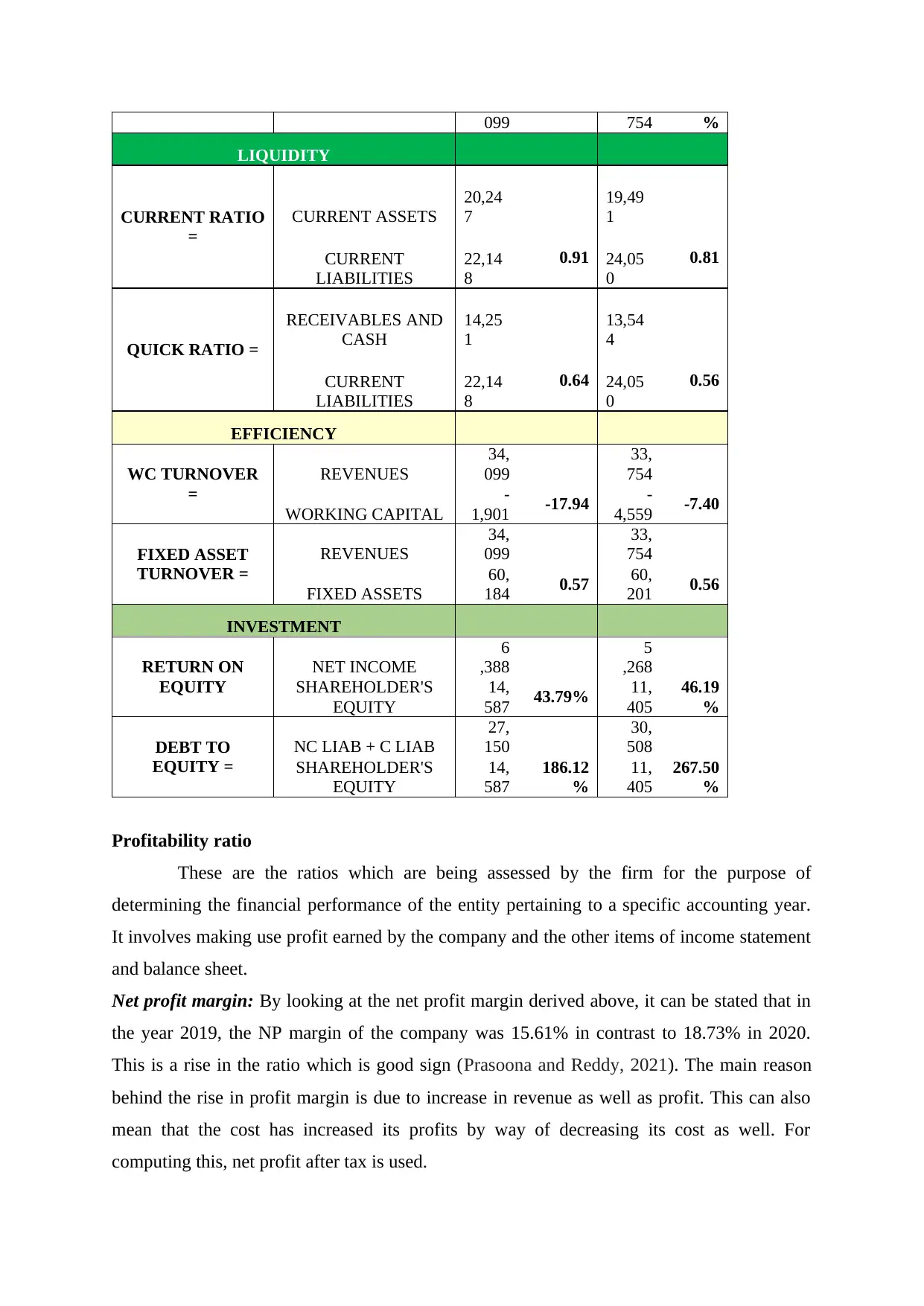
099 754 %
LIQUIDITY
CURRENT RATIO
=
CURRENT ASSETS
20,24
7
19,49
1
CURRENT
LIABILITIES
22,14
8
0.91 24,05
0
0.81
QUICK RATIO =
RECEIVABLES AND
CASH
14,25
1
13,54
4
CURRENT
LIABILITIES
22,14
8
0.64 24,05
0
0.56
EFFICIENCY
WC TURNOVER
=
REVENUES
34,
099
33,
754
WORKING CAPITAL
-
1,901 -17.94 -
4,559 -7.40
FIXED ASSET
TURNOVER =
REVENUES
34,
099
33,
754
FIXED ASSETS
60,
184 0.57 60,
201 0.56
INVESTMENT
RETURN ON
EQUITY
NET INCOME
6
,388
5
,268
SHAREHOLDER'S
EQUITY
14,
587 43.79% 11,
405
46.19
%
DEBT TO
EQUITY =
NC LIAB + C LIAB
27,
150
30,
508
SHAREHOLDER'S
EQUITY
14,
587
186.12
%
11,
405
267.50
%
Profitability ratio
These are the ratios which are being assessed by the firm for the purpose of
determining the financial performance of the entity pertaining to a specific accounting year.
It involves making use profit earned by the company and the other items of income statement
and balance sheet.
Net profit margin: By looking at the net profit margin derived above, it can be stated that in
the year 2019, the NP margin of the company was 15.61% in contrast to 18.73% in 2020.
This is a rise in the ratio which is good sign (Prasoona and Reddy, 2021). The main reason
behind the rise in profit margin is due to increase in revenue as well as profit. This can also
mean that the cost has increased its profits by way of decreasing its cost as well. For
computing this, net profit after tax is used.
LIQUIDITY
CURRENT RATIO
=
CURRENT ASSETS
20,24
7
19,49
1
CURRENT
LIABILITIES
22,14
8
0.91 24,05
0
0.81
QUICK RATIO =
RECEIVABLES AND
CASH
14,25
1
13,54
4
CURRENT
LIABILITIES
22,14
8
0.64 24,05
0
0.56
EFFICIENCY
WC TURNOVER
=
REVENUES
34,
099
33,
754
WORKING CAPITAL
-
1,901 -17.94 -
4,559 -7.40
FIXED ASSET
TURNOVER =
REVENUES
34,
099
33,
754
FIXED ASSETS
60,
184 0.57 60,
201 0.56
INVESTMENT
RETURN ON
EQUITY
NET INCOME
6
,388
5
,268
SHAREHOLDER'S
EQUITY
14,
587 43.79% 11,
405
46.19
%
DEBT TO
EQUITY =
NC LIAB + C LIAB
27,
150
30,
508
SHAREHOLDER'S
EQUITY
14,
587
186.12
%
11,
405
267.50
%
Profitability ratio
These are the ratios which are being assessed by the firm for the purpose of
determining the financial performance of the entity pertaining to a specific accounting year.
It involves making use profit earned by the company and the other items of income statement
and balance sheet.
Net profit margin: By looking at the net profit margin derived above, it can be stated that in
the year 2019, the NP margin of the company was 15.61% in contrast to 18.73% in 2020.
This is a rise in the ratio which is good sign (Prasoona and Reddy, 2021). The main reason
behind the rise in profit margin is due to increase in revenue as well as profit. This can also
mean that the cost has increased its profits by way of decreasing its cost as well. For
computing this, net profit after tax is used.
⊘ This is a preview!⊘
Do you want full access?
Subscribe today to unlock all pages.

Trusted by 1+ million students worldwide
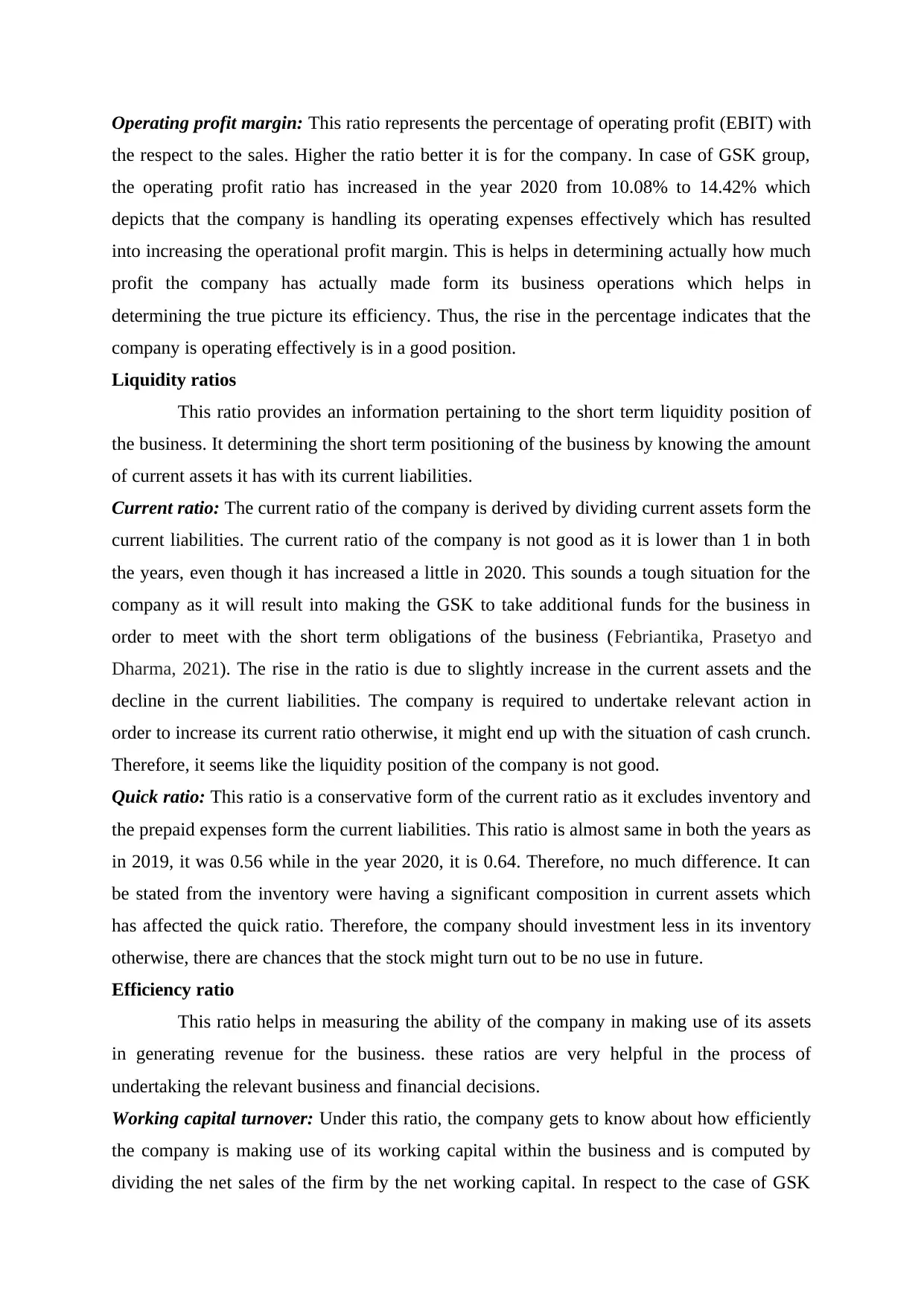
Operating profit margin: This ratio represents the percentage of operating profit (EBIT) with
the respect to the sales. Higher the ratio better it is for the company. In case of GSK group,
the operating profit ratio has increased in the year 2020 from 10.08% to 14.42% which
depicts that the company is handling its operating expenses effectively which has resulted
into increasing the operational profit margin. This is helps in determining actually how much
profit the company has actually made form its business operations which helps in
determining the true picture its efficiency. Thus, the rise in the percentage indicates that the
company is operating effectively is in a good position.
Liquidity ratios
This ratio provides an information pertaining to the short term liquidity position of
the business. It determining the short term positioning of the business by knowing the amount
of current assets it has with its current liabilities.
Current ratio: The current ratio of the company is derived by dividing current assets form the
current liabilities. The current ratio of the company is not good as it is lower than 1 in both
the years, even though it has increased a little in 2020. This sounds a tough situation for the
company as it will result into making the GSK to take additional funds for the business in
order to meet with the short term obligations of the business (Febriantika, Prasetyo and
Dharma, 2021). The rise in the ratio is due to slightly increase in the current assets and the
decline in the current liabilities. The company is required to undertake relevant action in
order to increase its current ratio otherwise, it might end up with the situation of cash crunch.
Therefore, it seems like the liquidity position of the company is not good.
Quick ratio: This ratio is a conservative form of the current ratio as it excludes inventory and
the prepaid expenses form the current liabilities. This ratio is almost same in both the years as
in 2019, it was 0.56 while in the year 2020, it is 0.64. Therefore, no much difference. It can
be stated from the inventory were having a significant composition in current assets which
has affected the quick ratio. Therefore, the company should investment less in its inventory
otherwise, there are chances that the stock might turn out to be no use in future.
Efficiency ratio
This ratio helps in measuring the ability of the company in making use of its assets
in generating revenue for the business. these ratios are very helpful in the process of
undertaking the relevant business and financial decisions.
Working capital turnover: Under this ratio, the company gets to know about how efficiently
the company is making use of its working capital within the business and is computed by
dividing the net sales of the firm by the net working capital. In respect to the case of GSK
the respect to the sales. Higher the ratio better it is for the company. In case of GSK group,
the operating profit ratio has increased in the year 2020 from 10.08% to 14.42% which
depicts that the company is handling its operating expenses effectively which has resulted
into increasing the operational profit margin. This is helps in determining actually how much
profit the company has actually made form its business operations which helps in
determining the true picture its efficiency. Thus, the rise in the percentage indicates that the
company is operating effectively is in a good position.
Liquidity ratios
This ratio provides an information pertaining to the short term liquidity position of
the business. It determining the short term positioning of the business by knowing the amount
of current assets it has with its current liabilities.
Current ratio: The current ratio of the company is derived by dividing current assets form the
current liabilities. The current ratio of the company is not good as it is lower than 1 in both
the years, even though it has increased a little in 2020. This sounds a tough situation for the
company as it will result into making the GSK to take additional funds for the business in
order to meet with the short term obligations of the business (Febriantika, Prasetyo and
Dharma, 2021). The rise in the ratio is due to slightly increase in the current assets and the
decline in the current liabilities. The company is required to undertake relevant action in
order to increase its current ratio otherwise, it might end up with the situation of cash crunch.
Therefore, it seems like the liquidity position of the company is not good.
Quick ratio: This ratio is a conservative form of the current ratio as it excludes inventory and
the prepaid expenses form the current liabilities. This ratio is almost same in both the years as
in 2019, it was 0.56 while in the year 2020, it is 0.64. Therefore, no much difference. It can
be stated from the inventory were having a significant composition in current assets which
has affected the quick ratio. Therefore, the company should investment less in its inventory
otherwise, there are chances that the stock might turn out to be no use in future.
Efficiency ratio
This ratio helps in measuring the ability of the company in making use of its assets
in generating revenue for the business. these ratios are very helpful in the process of
undertaking the relevant business and financial decisions.
Working capital turnover: Under this ratio, the company gets to know about how efficiently
the company is making use of its working capital within the business and is computed by
dividing the net sales of the firm by the net working capital. In respect to the case of GSK
Paraphrase This Document
Need a fresh take? Get an instant paraphrase of this document with our AI Paraphraser
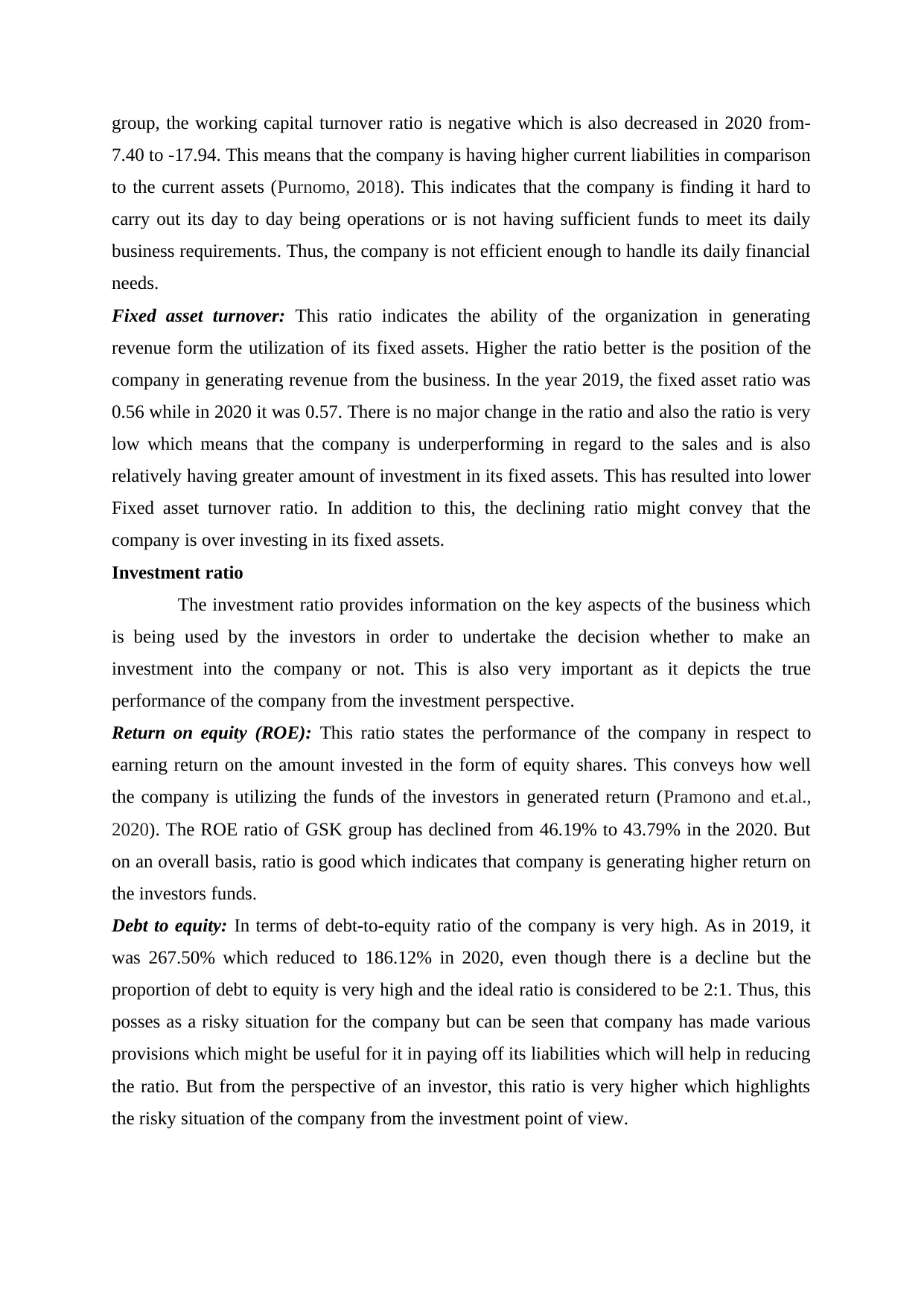
group, the working capital turnover ratio is negative which is also decreased in 2020 from-
7.40 to -17.94. This means that the company is having higher current liabilities in comparison
to the current assets (Purnomo, 2018). This indicates that the company is finding it hard to
carry out its day to day being operations or is not having sufficient funds to meet its daily
business requirements. Thus, the company is not efficient enough to handle its daily financial
needs.
Fixed asset turnover: This ratio indicates the ability of the organization in generating
revenue form the utilization of its fixed assets. Higher the ratio better is the position of the
company in generating revenue from the business. In the year 2019, the fixed asset ratio was
0.56 while in 2020 it was 0.57. There is no major change in the ratio and also the ratio is very
low which means that the company is underperforming in regard to the sales and is also
relatively having greater amount of investment in its fixed assets. This has resulted into lower
Fixed asset turnover ratio. In addition to this, the declining ratio might convey that the
company is over investing in its fixed assets.
Investment ratio
The investment ratio provides information on the key aspects of the business which
is being used by the investors in order to undertake the decision whether to make an
investment into the company or not. This is also very important as it depicts the true
performance of the company from the investment perspective.
Return on equity (ROE): This ratio states the performance of the company in respect to
earning return on the amount invested in the form of equity shares. This conveys how well
the company is utilizing the funds of the investors in generated return (Pramono and et.al.,
2020). The ROE ratio of GSK group has declined from 46.19% to 43.79% in the 2020. But
on an overall basis, ratio is good which indicates that company is generating higher return on
the investors funds.
Debt to equity: In terms of debt-to-equity ratio of the company is very high. As in 2019, it
was 267.50% which reduced to 186.12% in 2020, even though there is a decline but the
proportion of debt to equity is very high and the ideal ratio is considered to be 2:1. Thus, this
posses as a risky situation for the company but can be seen that company has made various
provisions which might be useful for it in paying off its liabilities which will help in reducing
the ratio. But from the perspective of an investor, this ratio is very higher which highlights
the risky situation of the company from the investment point of view.
7.40 to -17.94. This means that the company is having higher current liabilities in comparison
to the current assets (Purnomo, 2018). This indicates that the company is finding it hard to
carry out its day to day being operations or is not having sufficient funds to meet its daily
business requirements. Thus, the company is not efficient enough to handle its daily financial
needs.
Fixed asset turnover: This ratio indicates the ability of the organization in generating
revenue form the utilization of its fixed assets. Higher the ratio better is the position of the
company in generating revenue from the business. In the year 2019, the fixed asset ratio was
0.56 while in 2020 it was 0.57. There is no major change in the ratio and also the ratio is very
low which means that the company is underperforming in regard to the sales and is also
relatively having greater amount of investment in its fixed assets. This has resulted into lower
Fixed asset turnover ratio. In addition to this, the declining ratio might convey that the
company is over investing in its fixed assets.
Investment ratio
The investment ratio provides information on the key aspects of the business which
is being used by the investors in order to undertake the decision whether to make an
investment into the company or not. This is also very important as it depicts the true
performance of the company from the investment perspective.
Return on equity (ROE): This ratio states the performance of the company in respect to
earning return on the amount invested in the form of equity shares. This conveys how well
the company is utilizing the funds of the investors in generated return (Pramono and et.al.,
2020). The ROE ratio of GSK group has declined from 46.19% to 43.79% in the 2020. But
on an overall basis, ratio is good which indicates that company is generating higher return on
the investors funds.
Debt to equity: In terms of debt-to-equity ratio of the company is very high. As in 2019, it
was 267.50% which reduced to 186.12% in 2020, even though there is a decline but the
proportion of debt to equity is very high and the ideal ratio is considered to be 2:1. Thus, this
posses as a risky situation for the company but can be seen that company has made various
provisions which might be useful for it in paying off its liabilities which will help in reducing
the ratio. But from the perspective of an investor, this ratio is very higher which highlights
the risky situation of the company from the investment point of view.
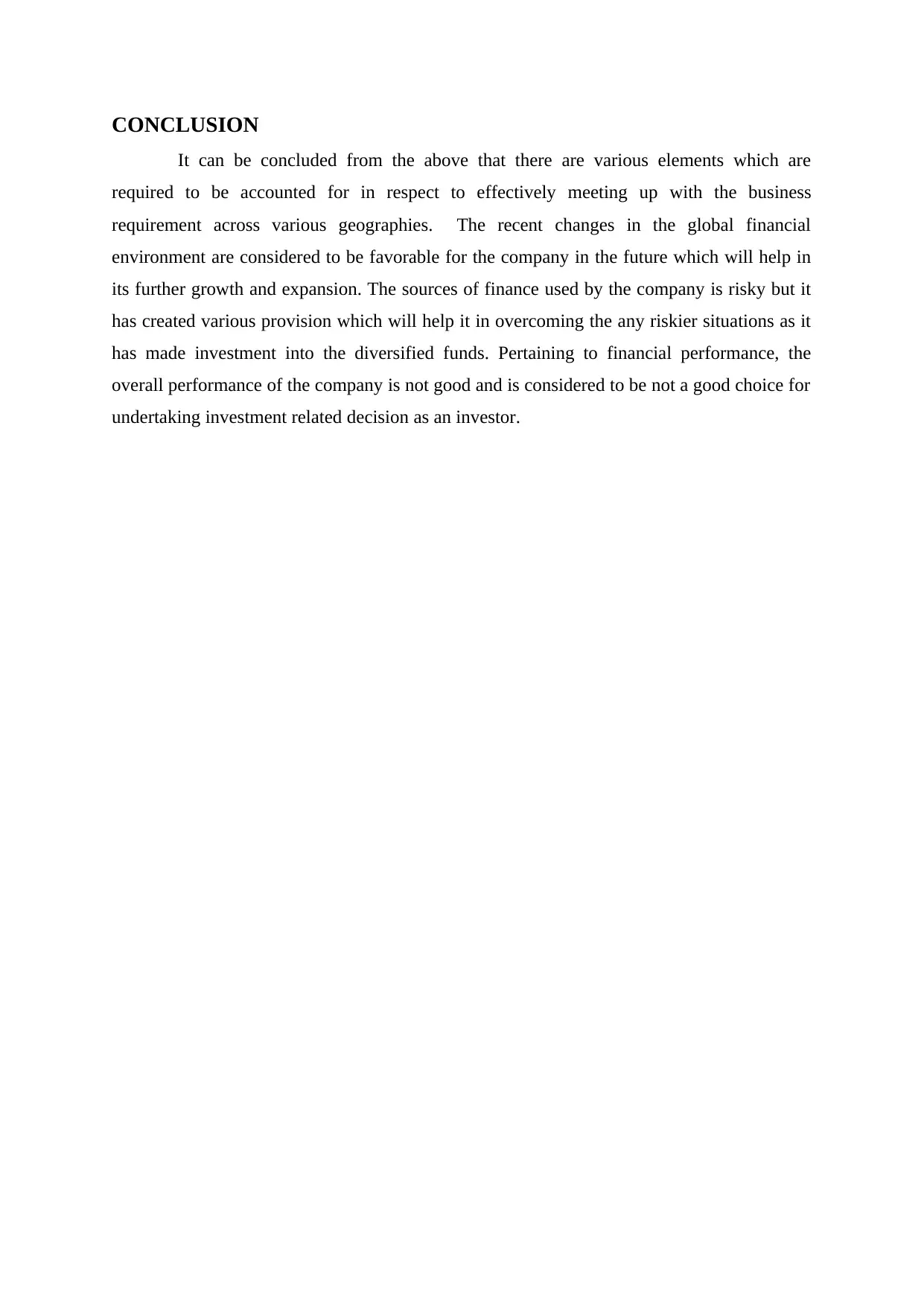
CONCLUSION
It can be concluded from the above that there are various elements which are
required to be accounted for in respect to effectively meeting up with the business
requirement across various geographies. The recent changes in the global financial
environment are considered to be favorable for the company in the future which will help in
its further growth and expansion. The sources of finance used by the company is risky but it
has created various provision which will help it in overcoming the any riskier situations as it
has made investment into the diversified funds. Pertaining to financial performance, the
overall performance of the company is not good and is considered to be not a good choice for
undertaking investment related decision as an investor.
It can be concluded from the above that there are various elements which are
required to be accounted for in respect to effectively meeting up with the business
requirement across various geographies. The recent changes in the global financial
environment are considered to be favorable for the company in the future which will help in
its further growth and expansion. The sources of finance used by the company is risky but it
has created various provision which will help it in overcoming the any riskier situations as it
has made investment into the diversified funds. Pertaining to financial performance, the
overall performance of the company is not good and is considered to be not a good choice for
undertaking investment related decision as an investor.
⊘ This is a preview!⊘
Do you want full access?
Subscribe today to unlock all pages.

Trusted by 1+ million students worldwide
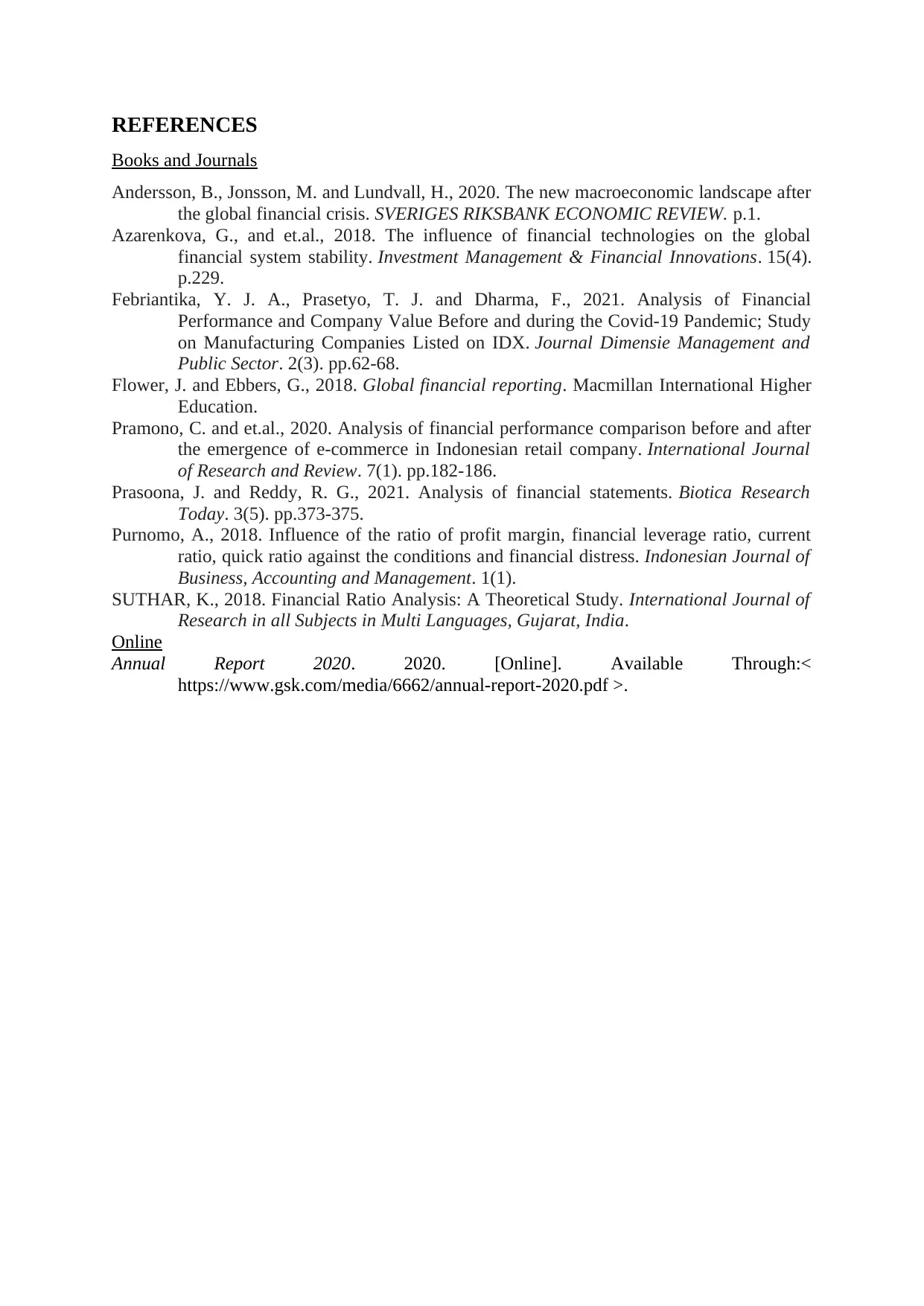
REFERENCES
Books and Journals
Andersson, B., Jonsson, M. and Lundvall, H., 2020. The new macroeconomic landscape after
the global financial crisis. SVERIGES RIKSBANK ECONOMIC REVIEW. p.1.
Azarenkova, G., and et.al., 2018. The influence of financial technologies on the global
financial system stability. Investment Management & Financial Innovations. 15(4).
p.229.
Febriantika, Y. J. A., Prasetyo, T. J. and Dharma, F., 2021. Analysis of Financial
Performance and Company Value Before and during the Covid-19 Pandemic; Study
on Manufacturing Companies Listed on IDX. Journal Dimensie Management and
Public Sector. 2(3). pp.62-68.
Flower, J. and Ebbers, G., 2018. Global financial reporting. Macmillan International Higher
Education.
Pramono, C. and et.al., 2020. Analysis of financial performance comparison before and after
the emergence of e-commerce in Indonesian retail company. International Journal
of Research and Review. 7(1). pp.182-186.
Prasoona, J. and Reddy, R. G., 2021. Analysis of financial statements. Biotica Research
Today. 3(5). pp.373-375.
Purnomo, A., 2018. Influence of the ratio of profit margin, financial leverage ratio, current
ratio, quick ratio against the conditions and financial distress. Indonesian Journal of
Business, Accounting and Management. 1(1).
SUTHAR, K., 2018. Financial Ratio Analysis: A Theoretical Study. International Journal of
Research in all Subjects in Multi Languages, Gujarat, India.
Online
Annual Report 2020. 2020. [Online]. Available Through:<
https://www.gsk.com/media/6662/annual-report-2020.pdf >.
Books and Journals
Andersson, B., Jonsson, M. and Lundvall, H., 2020. The new macroeconomic landscape after
the global financial crisis. SVERIGES RIKSBANK ECONOMIC REVIEW. p.1.
Azarenkova, G., and et.al., 2018. The influence of financial technologies on the global
financial system stability. Investment Management & Financial Innovations. 15(4).
p.229.
Febriantika, Y. J. A., Prasetyo, T. J. and Dharma, F., 2021. Analysis of Financial
Performance and Company Value Before and during the Covid-19 Pandemic; Study
on Manufacturing Companies Listed on IDX. Journal Dimensie Management and
Public Sector. 2(3). pp.62-68.
Flower, J. and Ebbers, G., 2018. Global financial reporting. Macmillan International Higher
Education.
Pramono, C. and et.al., 2020. Analysis of financial performance comparison before and after
the emergence of e-commerce in Indonesian retail company. International Journal
of Research and Review. 7(1). pp.182-186.
Prasoona, J. and Reddy, R. G., 2021. Analysis of financial statements. Biotica Research
Today. 3(5). pp.373-375.
Purnomo, A., 2018. Influence of the ratio of profit margin, financial leverage ratio, current
ratio, quick ratio against the conditions and financial distress. Indonesian Journal of
Business, Accounting and Management. 1(1).
SUTHAR, K., 2018. Financial Ratio Analysis: A Theoretical Study. International Journal of
Research in all Subjects in Multi Languages, Gujarat, India.
Online
Annual Report 2020. 2020. [Online]. Available Through:<
https://www.gsk.com/media/6662/annual-report-2020.pdf >.
1 out of 10
Related Documents
Your All-in-One AI-Powered Toolkit for Academic Success.
+13062052269
info@desklib.com
Available 24*7 on WhatsApp / Email
![[object Object]](/_next/static/media/star-bottom.7253800d.svg)
Unlock your academic potential
Copyright © 2020–2025 A2Z Services. All Rights Reserved. Developed and managed by ZUCOL.





